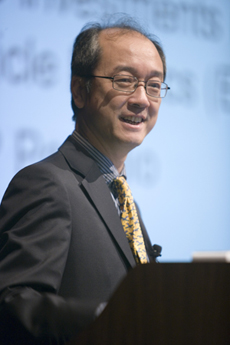| Thursday, June 8, 2007 |
| Subscribe | Contact Fermilab Today | Archive | Classifieds |
Policymakers share view on LHC, ILC and budgetsTwo weeks ago, Tony Chan visited CERN and toured the Large Hadron Collider. Yesterday, at the annual Users' meeting, he compared the LHC to sending the first man to the moon. "You are doing this for mankind," said Chan, who is the Assistant Director for Mathematics and Physical Sciences for the National Science Foundation. "Many of the scientists that I met at CERN are U.S. scientists. "NSF is and expects to remain a strong supporter of the Fermilab experimental program and its broader impacts," Chan said. "We have a history of successful partnerships with the DOE Office of High Energy Physics." As an example, he cited the LHC. NSF and DOE contributed a total of $531 million dollar toward the construction of the LHC and its detectors. Together with DOE's Robin Staffin, Chan represents the U.S. in the international Funding Agencies for a Large Collider organization. Speaking about the American Competitiveness Initiative, Chan pointed out the MPS has the largest budget within NSF and is "ACI-central." In FY08, MPS is to receive an 8.9% budget increase over FY07. While NSF-funded particle physics programs will not necessarily see the same increase, "it is the rising tide that helps everything." Kathryn Beers, of the Office of Science and Technology Policy, spoke about the need for interagency cooperation among DOE, NSF and NASA, as well as for international planning "as we see for the ILC and ITER." But she asked, "Where is the business model for this? Where are the good examples? Where are the case studies.to avoid the pitfalls? Our office wants to be part of that discussion." Many areas of research, from biological sciences to nanotechnology, are getting more expensive, too, and are competing for the same money. Although she is a trained chemist, Beers thinks that particle physics will endure. "You are masters of inspiring the imagination and creativity of the general public. They support you completely in your quest to understand the universe, and that has a value, too," she said. "We need to think about how we weigh that compared to economic benefits in the long run. The reality is that high-energy physics will outlast the American Competitiveness Initiative." For Michael Turner, University of Chicago and member of the Fermi Research Association Board of Directors, it is crucial that Fermilab maintain a vibrant research program to capture the imagination of young students. He highlighted the race for the Higgs boson and other big scientific opportunities ahead. "This is really what gets young people excited. This is a big opportunity, posed to this laboratory, to continue U.S. leadership in elementary particle physics." He later added, "If this lab is not healthy, the U.S. research community will not be healthy." -- Kurt Riesselmann |
